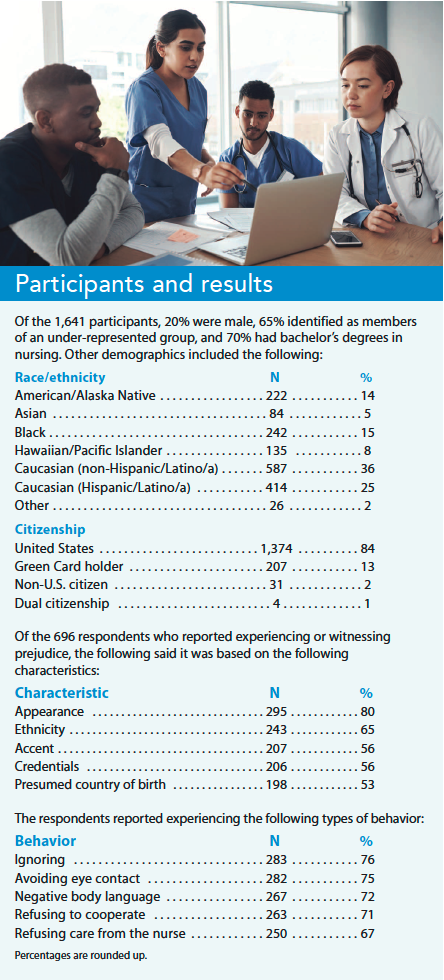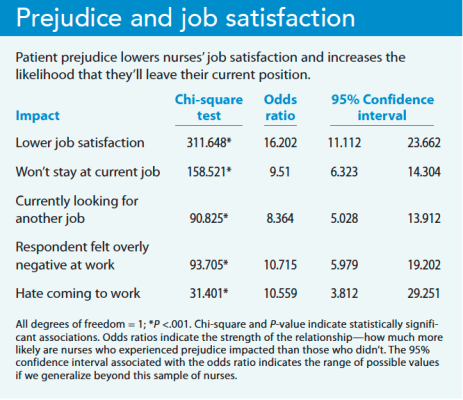Organization-wide interventions present the best option for addressing patient behavior and maintaining nurse retention.
- Many patients expect that the nurse who cares for them will be White and female, despite the growing diversity of the nursing workforce.
- Studies have revealed a perceived “triple challenge” of having to work harder to navigate and negotiate relationships with patients, coworkers, and supervisors.
- Organization-wide overhauls, rather than a single workshop, may better identify attitudes and actions that consciously or unconsciously perpetuate prejudice.
Nurses spend more time with patients than any other group of professionals, leading to prolonged and intimate contact with patients and their families. Although respect for all patients and visitors serves as a universal nursing ethic, what about the reverse? Specifically, how do patients treat nurses from minority backgrounds?
Strategies to combat implicit bias in nursing
When a patient refuses a nurse assignment
Addressing implicit bias in nursing: What color is your lens?
Implicit bias in healthcare, efforts to diversify the nursing workforce, and the impact of patient prejudice against nurses helped form the basis for our study. We aimed to gain insight into the experience of minoritized nurses who encounter overt and covert behaviors of prejudice, as well as offer suggestions for supportive, educational, and preventive interventions.
Implicit bias in healthcare
Several studies have validated that discrimination occurs toward patients from minority backgrounds, frequently as a result of implicit bias (unconscious attitudes that shape behavior, frequently in a negative way). Although most work on implicit bias has focused on racism in medicine, evidence exists that some nurses also have these unconscious negative attitudes toward specific groups of patients.
For example, French and others found that student nurses preferred not to care for patients who were overweight, elderly, or mentally ill. Research by Haider and colleagues surveyed a sample of predominantly White nurses who suggested that they had no preference for particular patient demographics, although their implicit bias scores suggested the opposite.
Diverse nursing workforce
The nursing profession faces pressure to increase workforce diversity to provide culturally competent care and meet the needs of a rapidly aging global population. COVID-19 and reduced retention and morale among healthcare workers makes this goal especially difficult to meet. Suggested approaches to increasing diversity include recruiting trainees from previously underrepresented groups. However, retention challenges remain, in some cases because of an adverse workplace.
According to Bell, many patients expect that the nurse who cares for them will be White and female even though the number of men in nursing has doubled to 13% in the past 3 years. The profession also includes various ethnicities. Of 4 million nurses surveyed, 8.1% reported that they’re Hispanic, 14.5% Black or African American, and 8.9% Asian. Although these changes represent a welcome trend, nurses who don’t fit the expected stereotype can become targets for prejudiced behaviors.
Patient prejudice toward nurses
Mistreatment from patients can depress and discourage healthcare providers. When Moceri interviewed 111 Hispanic nurses, they reported feeling demoralized when patients questioned their competency and legitimacy. According to Iheduru-Anderson and Wahi, six Nigerian nurses transitioning to practice in the United States reported serious emotional distress related to racist patients. In a study by Iheduru-Anderson, Agomoh, and Inungu, 17 African-born nurses reported that, in contrast with their American-born counterparts, they lacked authentic leadership and were treated with disrespect and undermined. Another study by Cottingham and colleagues analyzed 48 audio diaries kept by nurses of color. They revealed a perceived “triple challenge” of having to work harder to navigate and negotiate relationships with patients, coworkers, and supervisors.
These results confirm the findings of Iheduru-Anderson, Shingles, and Akanegbu’s integrative review of 23 studies, which suggests that the nursing profession is plagued by prejudice at all levels and in all settings.
To gain a better understanding of the racism, biases, and discrimination directed toward nurses by patients, we examined the experience of workplace prejudice experienced by minoritized nurses.
The survey
We developed the Prejudice Toward Nurses (PtN) survey based on previous qualitative work by Dellasega and Andreae. In addition to demographics, the survey asked participants to quantify the frequency of patient prejudice, describe the types of behaviors directed at them, and explain the impact.
We assessed a range of overt behaviors (such as comments made about appearance, accent, name, status as a trainee, and qualifications/credentials) as well as covert behaviors (such as not making eye contact or ignoring). The PtN survey also asked respondents to indicate how frequently and what type of prejudiced behavior they had witnessed toward other minoritized nurses.
The participants and procedures


To calculate the frequency of PtN as well as the type of prejudice and specific behaviors, we used SPSS v 28.0.1.0. We rounded up percentages and determined the impact of PtN using chi-square analysis.
Most participants were female (1,288; 335 were male or didn’t specify), with an age range of 21 to 78 years (M = 33.170; SD = 9.130) and 1 to 56 years of nursing experience (M = 6.860; SD = 7.809).
Of those who self-identified, over half were Hispanic/Latino(a) or non-Hispanic/Latino(a) (61%). Black (15%) and Other (American Alaska Native, Asian, Hawaiian/Pacific Islander) accounted for the remainder. Most respondents were U.S. Citizens (85%).
Prejudice experienced and witnessed
One-third of participants reported experiencing some form of prejudice directed toward them in the workplace. The most common prejudice was based on appearance and expressed covertly. However, 67% of respondents reported that patients rejected them as care providers.
Nearly half (42%) of respondents reported that they had witnessed prejudice directed against other nurses because of their race, ethnicity, or cultural background. These 696 nurses reported seeing prejudice most frequently in the form of comments about another minoritized nurses’ appearance or accent, and that most behaviors were expressed overtly (such as eye rolling, sighing, turning away). (See Participants and results.)
Prejudice impact
Nurses experiencing prejudice reported that it negatively impacted their job satisfaction. In addition, nurses in this study were significantly more likely to have left a prior position as a result of experiencing prejudice (c2[1] = 5.267, P = .022; OR = 1.572 [95% CI = 1.067-2.317]). (See Prejudice and job satisfaction.)
What we learned
To our knowledge, this survey is the first to describe the prevalence and impact of prejudice toward minoritized nurses. Although limited by the self-selected sample, results suggest that nearly one-third of respondents experienced both overt and subtle forms of prejudice by patients and nearly half witnessed it occurring to another nurse. Behaviors frequently related to the appearance and ethnicity of the nurse with age, country of origin, and ethnicity as significant predictors.


Equally concerning is the emotional impact on job satisfaction for nurses targeted with prejudiced behavior. Two variables—job satisfaction and intent-to-stay—predict individual mental and physical well-being as well as organizational operation and other outcomes, which can present a serious challenge in hospitals and clinics with rampant PtN.
Although limited by a new, untested survey, these data shed light on possible contributors to the current crisis of nurse burnout and staffing shortages as well as the serious negative impact on the well-being of both patients and nurses documented by Kieft and colleagues. Enhanced recruitment of nurses from diverse backgrounds is successful only if paired with enhanced retention, which isn’t suggested by these results.
What we can do
How can we change PtN? Unfortunately, no single solution exists that can create harmony within diverse institutions. However, in our preliminary interviews with minoritized healthcare providers, it was suggested that training for all employees, both during onboarding and regularly thereafter, might address the issue. (See Interventions.)
Interviewees also suggested strategies such as cognitive rehearsals that allow both minoritized and non-minoritized nurses to practice responding to prejudiced behaviors and action plans that contain techniques for responding to overt and covert prejudice. Students and new nurses who are especially vulnerable to negativity due to their educational status require preparation to take action for themselves and others.
In addition, organization-wide overhauls, rather than a single workshop that checks a diversity box, may better identify attitudes and actions that consciously or unconsciously perpetuate prejudice. For example, research suggests that implicit bias can negatively influence the types of images, words, and behaviors used to advertise and promote an organization and its workforce.
Interventions
Organization-wide interventions to prevent and mitigate prejudice by patients against nurses should include the following:
- Initial and continuing education on nurses’ experience of prejudice
- Cognitive rehearsals
- Proactive action plan for responding to or witnessing prejudice
- Advocacy for trainees
- Institutional awareness and change
Stand united
The implications for patients, nurses, their employers, and all of healthcare are clear as we continue to work on expanding and diversifying the nursing workforce. Although nursing school enrollment continues to increase, providing a work environment where all nurses can thrive presents the next challenge.
Whether we’re part of the minority groups surveyed in this study, our work life, patient care, and well-being are impacted when our environment is rendered toxic by prejudiced behaviors. As a profession recognized to be healing, let’s stand united with all of our colleagues, ready to confront and resolve the emotional, physical, and professional distress prejudice toward nurses creates.
Cheryl Dellasega is a professor in the department of humanities at Pennsylvania State College of Medicine in Hershey. Doerthe Adriana Andreae is an associate professor of allergy and immunology in the department of dermatology at the University of Utah in Salt Lake City. Miranda P. Kaye works in the Survey Research Center at Pennsylvania State University. Olubukola Toyobo is a resident physician in internal medicine at Memorial Health Care System in Miami, Florida.
American Nurse Journal. 2023; 18(12). Doi: 10.51256/ANJ122312
References
Alexander GR, Johnson Jr JH. Disruptive demographics: Their effects on nursing demand, supply and academic preparation. Nurs Adm Q. 2021;45(1):58-64. doi:10.1097/NAQ.0000000000000449
American Association of Colleges of Nursing. Enhancing diversity in the nursing workforce. April 2023. aacnnursing.org/news-data/fact-sheets/enhancing-diversity-in-the-nursing-workforce
Bell B. White dominance in nursing education: A target for anti-racist efforts. Nurs Inq. 2021;28(1):e12379. doi:10.1111/nin.12379
Cottingham MD, Johnson AH, Erickson RJ. “I can never be too comfortable”: Race, gender, and emotion at the hospital bedside. Qual Health Res. 2018;28(1):145-58. doi:10.1177/1049732317737980
Dellasega C. Toxic Nursing: Managing Bullying, Bad Attitudes, and Total Turmoil. 2nd ed. Indianapois, IN: Sigma Theta Tau International; 2020.
Dellasega C, Andreae D. Stigma and bias from patients toward minoritized physicians and nurses. Paper presented at: 12th International Conference on Stigma (Trauma … Recovery … Healing). November 2021; Howard University; Washington, DC.
Dellasega C, Andreae DA, Boesch R. Patient prejudice toward nurses. American Nurse Journal. August 21, 2020. myamericannurse.com/patient-prejudice-toward-nurses
FitzGerald C, Hurst S. Implicit bias in healthcare professionals: A systematic review. BMC Med Ethics. 2017;18(1):19. doi:10.1186/s12910-017-0179-8
French S. Implicit Bias in Student Nurses [honors project]. Providence, RI: Rhode Island College School of Nursing; 2020.
Haider AH, Schneider EB, Sriram N, et al. Unconscious race and class biases among registered nurses: Vignette-based study using implicit association testing. J Am Coll Surg. 2015;220(6):1077-86.e3. doi:10.1016/j.jamcollsurg.2015.01.065
Iheduru-Anderson K, Shingles RR, Akanegbu C. Discourse of race and racism in nursing: An integrative review of literature. Public Health Nurs. 2021;38(1):115-30. doi:10.1111/phn.12828
Iheduru-Anderson KC, Agomoh CJ, Inungu J. African born black nurses’ perception of their U.S. work environment: Race matters. Nurs Outlook. 2021;69(3):409-24. doi:10.1016/j.outlook.2020.11.009
Iheduru-Anderson KC, Wahi MM. Experiences of Nigerian internationally educated nurses transitioning to United States health care settings. J Transcult Nurs. 2018;29(6):603-10. doi:10.1177/1043659618766225
Jung D, Latham C, Fortes K, Schwartz M. Using holistic admissions in pre-licensure programs to diversify the nursing workforce. J Prof Nurs. 2021;37(2):359-65. doi:10.1016/j.profnurs.2020.04.006
Kieft RA, de Brouwer BBJM, Francke AL, Delnoij DM. How nurses and their work environment affect patient experiences of the quality of care: A qualitative study. BMC Health Serv Res. 2014;14:249. doi:10.1186/1472-6963-14-249
Moceri JT. Hispanic nurses’ experiences of bias in the workplace. J Transcult Nurs. 2014;25(1):15-22. doi:10.1177/1043659613504109
Onyeador IN, Hudson STJ, Lewis NA. Moving beyond implicit bias training: Policy insights for increasing organizational diversity. Policy Insights Behav Brain Sci. 2021;8(1):19-26. doi:10.1177/2372732220983840
U.S. Bureau of Labor Statistics. Labor force statistics from the current population survey. January 25, 2023. https://www.bls.gov/cps/cpsaat11.htm
U.S. Department of Health and Human Services. 2018 national sample survey of registered nurses: Brief summary of results. 2019. bhw.hrsa.gov/sites/default/files/bureau-health-workforce/data-research/nssrn-summary-report.pdf
Key words: patient prejudice, implicit bias, minoritized nurses, disrespect


















